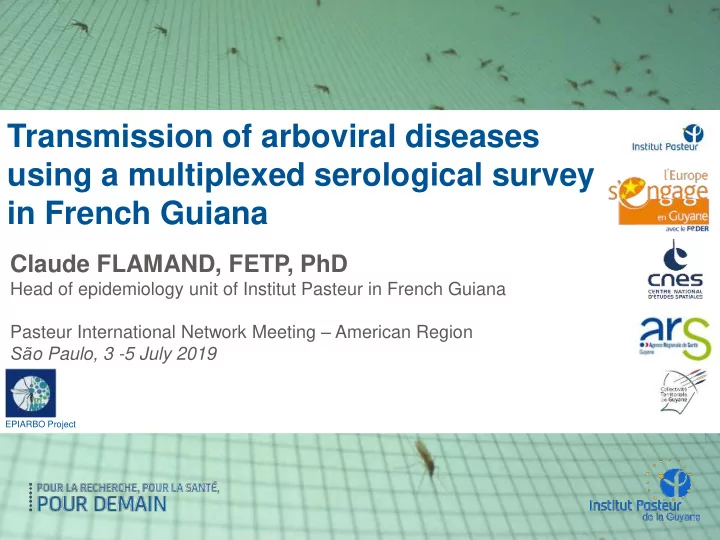

Transmission of arboviral diseases using a multiplexed serological survey in French Guiana Claude FLAMAND, FETP, PhD Head of epidemiology unit of Institut Pasteur in French Guiana Pasteur International Network Meeting – American Region Sā o Paulo, 3 -5 July 2019 EPIARBO Project
vectors vectors Aedes mosquitoes : A history of global expansion Ae. aegypti Ae. albopictus 2 Kraemer & al. (ELife, 2015)
vectors vectors Increasing risk of transmission of arbovirus Growing number of major outbreaks of DENV All four DENV serotypes in much global tropical and sub-tropical regions Chikungunya global distribution Large outbreak of Chikungunya in the Caraibbean and the Americas in 2013-2014 Large outbreak of Zika virus in the Americas in 2015 https://www.cdc.gov/chikungunya/geo/index.html Zika global distribution Yellow fever in Brazil and Angola in 2016-2017 3
Knowledge gaps in arbovirus spread and maintenance Common features of Epidemiological gaps arbovirus Frequent clinical misdiagnosis Transmission dynamics poorly understood Substantial asymptomatic infection True Burden rarely known Changing epidemiology Outbreak occurence Serological cross-reaction prediction remain difficult Impact of environmental drivers may Control efforts limited to vary according to geographical area ressource-intensive vector and spatial scale control activities and difficult to target Low specificity of serosurveys 4 in the context of co-circulation of closely related pathogens
French Guiana French overseas department, South America Population size : 250,000 inhabitants (~1 ‰ Brazil) Amazonian forest complex (3 inhab./km 2 ) Two main inhabited geographical regions A costal urbanized strip (90% population) Remote and river area along the frontiers High levels of immigration : ~40% of the population Various ethnic groups Creoles, European, Brazilians, Marrons, Amerindians, Chinese ,… Total fertility rate : 3.5 children p. women (6,700 births/year) 5 C. Flamand – Unité d’épidémiologie,, Institut Pasteur de la Guyane
Justification and objectives Presence of competent vector : Aedes aegypti Regular major DENV outbreaks (1991 – 2013) ~2-5% of the population (CC) Recent outbreaks of emergent arbovirus CHIKV (2014), ZIKV (2016) No seroprevance data available Impact of past epidemics Estimating future transmission risks Surveillance system coverage Assessing the impact of prevention strategies Implementation of an househould serosurvey Burden of diseases and spatial distribution of viruses 6 C. Flamand – Unité d’épidémiologie,, Institut Pasteur de la Guyane
Methodology Epidemiological cross-sectional study General population household survey 2 500 residents of FG (~1600 households) Target Population : [ 2 years – 75 years ] Stratified 2-stage sample design based on the size of municipality Questionnaire (Sociodemographic, environment, human behavior Serum sample : Multiplexed microsphere-based IgG Immunassay (Relative fluorescence intensity) DENV ; CHIKV ; ZIKV ; MAYV ; YF ; WN Seroneutralization tests (subsample) Age-stratified Modelling approach Reconstruction of history of circulation and the extent of cross-reactivity C. Flamand – Unité d’épidémiologie,, Institut Pasteur de la Guyane
Spatial distribution of enrolled subjects (N =2,697) C. Flamand – Unité d’épidémiologie,, Institut Pasteur de la Guyane
Exploring serological cross-correlations Alphaviruses DENV1-DENV4 Flaviviruses C. Flamand – Unité d’épidémiologie,, Institut Pasteur de la Guyane
From antibodies titer levels to serological status The example for CHIKV and MAYV CHIK serological status clearly identified MAYV response strongly impact CHIKV response Differences of antibodies responses according to age and location data Estimating location-specific forces of infection modulated by risk factors C. Flamand – Unité d’épidémiologie,, Institut Pasteur de la Guyane
Model-based classification of the infection status Determining infection status for Infection Titers (in log scale) MAYV and CHIK from individual RFI status (MAYV, Understanding how an infection CHIKV) t M = s 0 M + N(0, e M ) boosts the RFI for an assay and (0,0) cross-react with the other assay t C = s 0 C + N(0, e C ) Reconstructing the history of circulation using risk factors t M = s 0 M + s M + N(0, e M ) (1,0) t C = s 0 C + s M C t M + N(0, e C ) t M = s 0 M + s C M t C (0,1) +N(0, e M ) t C = s 0 C + s C + N(0, e C ) t M = s 0 M + s M +N(0, e M ) (1,1) t C = s 0 C + s C + N(0, e C ) C. Flamand – Unité d’épidémiologie,, Institut Pasteur de la Guyane
Validation with seroneutralization results Model-based classification vs simple optimized cut-off C. Flamand – Unité d’épidémiologie,, Institut Pasteur de la Guyane
Estimating the burden of arboviruses ZIKV DENV CHIKV MAYV 69.7% [66.2% – 71.0%] 23.1% [19.5% – 27.2%] 20.3 [17.5% – 22.5%] 2.7% [ 2.1% – 3.4%] High level of infection Large transmission in West Maroni river Sylvatic constant the most important highly infected transmission Small variations in the municipalities North-western area++ Inland and amazonian areas exposed to forest area ++ Aedes aegypti Household North-Western area+ transmission ++ Male >20 years ++ 13
Conclusions and perspectives Determining the level of circulation of priority arboviruses at a country-level in South America Contribution of modelling techniques to assess viral circulation from detailed age-stratified seroprevalence data dealing with cross- reactivity issues Investigating DENV serotype-specific and YF seroprevalence Elucidating spatial differences in risks exploring more determinants population mobility, entomological risks, insecticide resistance, … Development opportunity to elaborate new research projects and establish partnerships to improve the understanding of transmission dynamics in South America C. Flamand – Unité d’épidémiologie,, Institut Pasteur de la Guyane
Aknowledgements Fundings C. Fritzell S. Bailly M. Kazanji S. Cauchemez A. Enfissi H. Salje D. Rousset J. Paireau S. Matheus B. Nikolay E. Hoze
www.pasteur-cayenne.fr C. Flamand – Unité d’épidémiologie,, Institut Pasteur de la Guyane
Recommend
More recommend